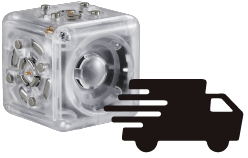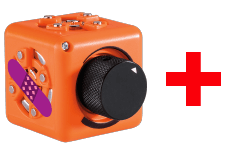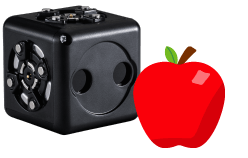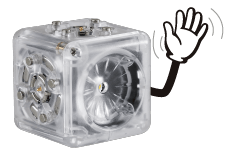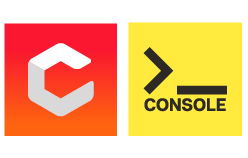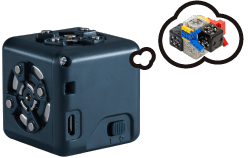Cubelets are at their most effective when all students are engaged and continuing to build their skill sets. However, as with any tool, some students will pick it up quickly, and others may need extra help. When teaching with Cubelets, it’s helpful to use the following rules of thumb about interventions and extensions for your robot challenges.
Interventions
First and foremost, to help students who struggle with designing effective robots, start by limiting the number of Cubelets they have access to at the beginning of the design challenge. If students only have n+1 Cubelet (one more Cubelet than they need to successfully build their challenge), they will be better able to focus on the challenge at hand.
It is helpful to tell your students what you’re doing, too. If they know you’re giving them a hint by giving them specific Cubelets, students can lean on that clue as they decompose the task. For instance, when designing a steering robot, you’ll be providing students with two matching SENSE Cubelets for their design. This can be a helpful hint that the robot will need to be looking in two different directions in order to successfully steer.
You may also strategically provide research materials that have exactly the clues students might need to be successful. Following the example above, providing articles or short youtube videos about how tracked vehicles turn can be extremely enlightening, especially since most students try to mimic cars and other vehicles with axles, and that is simply not how Cubelets work. There is no axle Cubelet to use for such a challenge.
You may need more involved interventions for some students. For these groups, start by outlining very clear success criteria for the challenge. Use the success criteria as a way to collaboratively decompose the task. This might sound like:
“We know these are the success criteria for the challenge. Which success criteria should we start with?”
“To meet only this criterion, what ideas do we have?”
“Where might we look to see how nature or other professionals have met this challenge before?”
Extensions
You will discover that you’ll rarely need extensions to your Cubelets lessons. One of the great things about Cubelets as a learning tool is that as students experience small successes, they become increasingly self-motivated to explore and extend their learning. In the event you are called upon to provide extension prompts, here are a few helpful tricks:
- Can you revise your robot to do the same task with fewer Cubelets? (Are your students allowed to use Personality Swaps or Cubelets Blockly to aid in this revision?)
- Can you design another robot that can complete the same task but looks completely different from your current design?
- Can you add onto your design an alert system that signals exactly when your robot begins to sense a change and adapt to the new input?
- Please record at least three other robots you built on your way to this robot and outline what your “ah-ha” was during each robot that led you to this design.
Regardless of your students, know you’re not alone! Every lesson plan posted on The Hub includes a section at the end devoted to student differentiation ideas divided into lesson-specific interventions and extensions. If you still have more questions or specific student needs that aren’t addressed specifically in our resources, please reach out to our customer support team at support@modrobotics.com. They’ll put you in contact with an on-staff educator who can collaborate with you to make sure Cubelets are meeting all of the needs in your classroom!
Enjoyed this blog post? Sign up for the #CubeletsChat newsletter to receive the next blog post straight to your inbox. Plus join the discussion on twitter using the #CubeletsChat hashtag!








